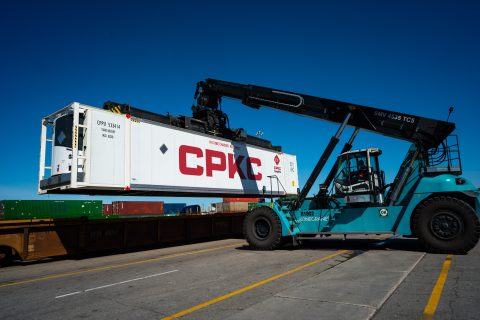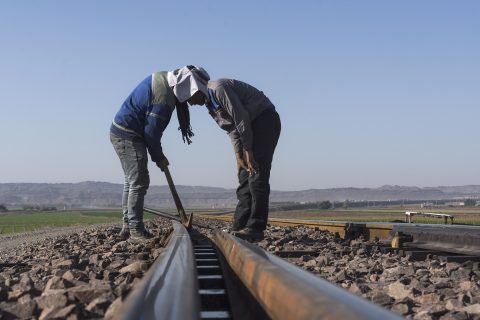Ukraine integration on EU railways: different gauge not the only obstacle

Integrating Ukraine into the European rail network in an efficient manner became quite a relevant topic since the war has started. However, as a study recently published by the European Investment Bank and the European Commission shows, the path is winding and the gauge difference is not the only hurdle.
The study analysed options for the implementation of the standard gauge (1435mm) in Ukraine, where trains run on the broad gauge (1520mm). The preferred option highlighted by the study is the development of a standard gauge network that would operate in conjunction with the existing broad gauge one.
The study specified that the new standard gauge lines are foreseen as conventional, not high-speed and that would be implemented from West to East. Initially, implementing a 1435mm gauge network in Ukraine should focus on connecting Kyiv to L’viv, Kharkiv, and Dnipro. However, there are several other challenges that need to be addressed before a proper integration process can be established.
The gauge question
The new 1435mm network would be dedicated to rail freight services for containers and intermodal transport. Moreover, national and international passenger trains would also run on this network. On the other hand, the existing 1520mm network would be used for heavier freight trains, such as the ones transporting raw materials and agricultural products. Local and night passenger trains would keep running on this network. The study suggests that future investments in modernising the broad gauge network should take into account a possible migration to the standard gauge. A solution for this would be the deployment of polyvalent sleepers, which would accommodate both gauges.
The installation of the 1435mm gauge in Ukraine would pose significant challenges also for existing infrastructure. Maintenance facilities, shunting, and marshalling yards would all be required to accommodate both gauges. This would also mean that new itineraries within the facilities would need to be drawn up to ensure smooth circulation. However, the study pointed out that track superstructure, signalling, power supply, and Overhead Catenary System will be the most cost-impactful initiatives. For example, differences in electrification systems need solving. According to the study, the best solution would be “ that further electrification of the Ukrainian system is performed with the 25kV 50Hz AC system”.
Four viable options identified in the study
The study analysed four options for the implementation of the standard gauge in Ukraine that can be implemented in different areas of Ukraine. One solution would be to turn one of the 1520mm double tracks into a 1435mm single track. Despite being the cheapest solution, the study claims that this alternative would significantly cut capacity on the broad gauge network and only provide a single line with a standard gauge. Thus, it should be considered solely for areas with low-capacity utilisation.
Another solution considered by the study is to folly transform broad gauge double tracks into standard gauge double tracks. This option is the only option in the study that implies a future double-track 1435mm gauge. This alternative should be pursued only where 1520mm traffic is not expected to be relevant and 1435mm traffic is estimated to significantly increase. A similar initiative is proposed for broad gauge single-lines, with the same conditions to be applied.
The fourth option considered viable by the study is to build a new standard gauge single-track in parallel to the existing broad gauge double tracks. Since the 1520mm network would remain, current capacity should not be impacted. On the other hand, mixed traffic might lead to reliability and efficiency issues. Moreover, it is the only viable alternative that contemplated the purchase of new land, increasing possible risks and costs.
‘Ukraine should adapt to European Model of Rails’
As the study highlighted, another obstacle to Ukraine’s integration into the European rail network is the fact that Kyiv hasn’t adopted the European Model of Rails yet. One of its basic principles is that infrastructure management and Railway Undertakings in Europe should be two independent entities. On the other hand, in Ukraine, JSC Ukrainian Railways (UZ), the state-owned railway company, acts as both IM and RU.
The study underlined that “a clear political will to confront the difficulties of the reforms was missing at the legislative level”. Moreover, UZ shareholders did not provide the Supervisory Board with the KPIs related to these reforms. Despite this, it seems that something is moving. At the beginning of the year, the Ukrainian Ministry of Transport created a Working Group to update the Action Plan for reforming the rail industry.
Variable gauge rolling stock not an option for the long run
Another significant barrier that impedes a seamless transition for Ukraine from broad to standard gauge is the availability of rolling stock. This is especially true for rail freight, according to the study. The “lack of specialised freight wagons has been identified by the study as one critical issue for improved trade and integration” between Ukraine and the EU.
UZ is planning to purchase wagons and locomotives suitable for 1435mm gauge, including hopper and tank wagons as well as fitting platforms for containers. Variable gauge rolling stock, although, cannot be a long-term solution, the EIB study stated. This is because this technology has not yet proved suitable for freight wagons and would increase operational and maintenance costs as personnel would require to be trained.
Also read:
- Ukraine wants to cooperate with Spain to integrate on EU rail network
- Ukraine will deploy trains and barges for exports after Grain Deal breaks
- Ukrainian Railways goes international with new Polish branch
- Deal for standard gauge to Ukraine to be signed this month
You just read one of our premium articles free of charge
Want full access? Take advantage of our exclusive offer





